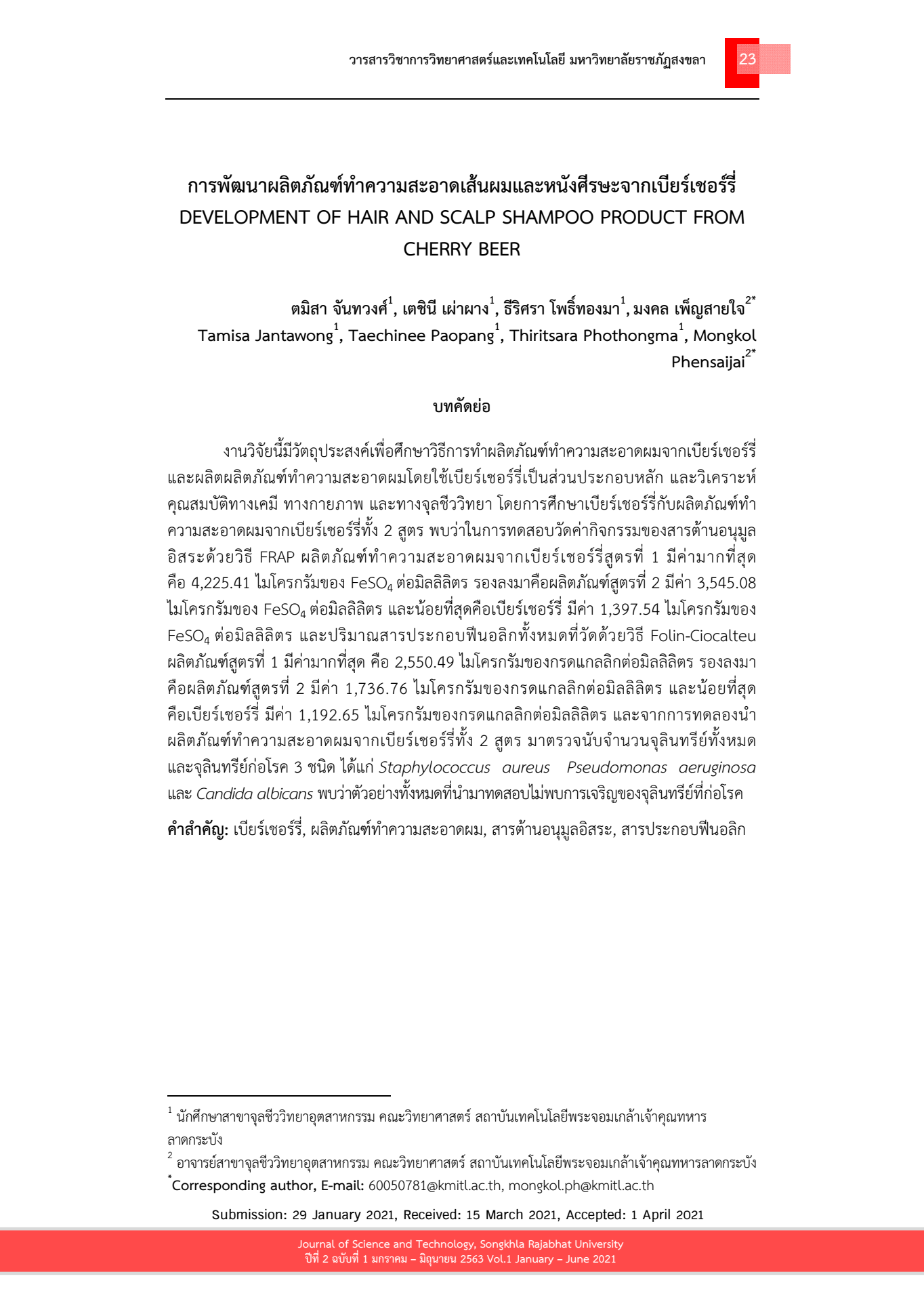Development of Hair and Scalp Shampoo Product from Cherry Beer
Keywords:
Cherry beer, Shampoo, Antioxidant, Phenolic compoundAbstract
The objective of this research was to study how to make a hair shampoo from cherry beer and the chemical, physical, and microbiological were analyzed. The study was found that cherry beer and both formulas hair shampoo from cherry beer showed antioxidant activity that evaluated by FRAP method. The result showed that the formula 1, formula 2 and cherry beer had antioxidant activity 4,225.41, 3545.08, 1397.54 micrograms of FeSO4 per milliliter, respectively. The result from evaluated Phenolic compounds by Folin-Ciocalteu method showed that formula 1, formula 2 and cherry beer were 2550.49, 1736.76 and 1192.65 micrograms of gallic acid per millimeter, respectively. In addition, the two formulas hair shampoo and cherry beer were tested by plate count method with 3 pathogenic microorganisms, Staphylococcus aureus, Pseudomonas aeruginosa and Candida albicans respectively. The result showed that there was no growth of pathogens.
References
กาญจนา นาคประสม, จตุรภัทร วาฤทธิ์, อุมาพร อุประ, หยาดฝน ทนงการกิจ และนักรบ นาคประสม. (2560). “สภาวะที่เหมาะสมในการสกัดสารประกอบฟีนอลิกรวมจากดอกบัวหลวงโดยใช้เทคนิคสกัดด้วยไมโครเวฟ.” วารสารวิทยาศาสตร์ มข. 45(2), 328-342.
นงลักษณ์ สุวรรณพินิจ และปรีชา สุวรรณพินิจ. (2541). อาหารเลี้ยงเชื้อและการเพาะเลี้ยงจุลินทรีย์. พิมพ์ครั้งที่ 2. ปทุมธานี: สำนักพิมพ์แห่งจุฬาลงกรณ์มหาวิทยาลัย.
วิเชียร วรพุทธพร และสุกัลยา ทาโบราณ. (2543). คู่มือปฏิบัติการจุลชีววิทยาของอาหาร. ขอนแก่น: มหาวิทยาลัยขอนแก่น.
สำนักงานมาตรฐานผลิตภัณฑ์กระทรวงอุตสาหกรรม. (2562). มาตรฐานอุตสาหกรรมเอส มอก. เอส 12-2562 แชมพูผสมสมุนไพร. ฉบับที่ 2.
สุชาดา มานอก และปวีณา ลิ้มเจริญ. (2558). “การวิเคราะห์ฤทธิ์ต้านอนุมูลอิสระโดยวิธี DPPH, ABTS และ FRAP และปริมาณสารประกอบฟีนอลิกทั้งหมดของสารสกัดสมุนไพรในตำรับยาหอมเทพจิตร.” ก้าวทันโลกวิทยาศาสตร์. 15(1), 106-117.
สุดใจ ปาวิชัย. (2540). การเปรียบเทียบวิธีการเก็บรักษาเชื้อจุลินทรีย์เพื่อใช้ในห้องปฏิบัติการ. เชียงใหม่: มหาวิทยาลัยเชียงใหม่.
สุภาพร รัตนพลที และอนุชสรา คำตัน. (2554). การตรวจสอบคุณภาพอาหาร เครื่องสำอาง และการพัฒนาคุณภาพผลิตภัณฑ์. กรุงเทพฯ: มหาวิทยาลัยเทคโนโลยีราชมงคลธัญบุรี.
Aquilani, B. Laureti, T. Poponi, S. and Secondi, L. (2015). “Beer choice and consumption determinants when craft beers are tasted: An exploratory study of consumer preferences.” Food Quality and Preference. 41(1), 214–224.
Basso, R.F. Alcarde, A.R. and Portugal, C.B. (2016). “Could non-Saccharomyces yeasts con-tribute on innovative brewing fermentations.” Food Research International. 6, 112– 120.
Beattie, J. Crozier, A. and Duthie, G.G. (2005). “Potential health benefits of berries.” Current Nutrition & Food Science. 1(1), 71-86.
Benzie, I.F.F. and Strain, J.J. (1996). “The ferric reducing ability of plasma (FRAP) as a measure of “Antioxidant power”: The FRAP assay.” Analytical Biochemistry. 239, 70–76.
Canonico, L. Comitini, F. and Ciani, M. (2014). “Dominance and influence of selected Saccharomyces cerevisiae strains on the analytical profile of craft beer refermentation.” The Institute of Brewing. 120(3), 262-267.
Ghiselli, A. Natella, F. Guidi, A. Montanari, L. Fantozzi, P. and Scaccini, C. (2000). “Beer increases plasma antioxidant capacity in humans.” The Journal of Nutritional Biochemistry. 11(2), 76-80.
Gomez, A.M. Caballero, I. and Blanco, C.A. (2020). “Phenols and melanoidins as natural antioxidants in beer : structure, reactivity and antioxidant activity.” Biomolecules. 10(400), 1-19.
Huang, J. Hitchins, A.D. Tran, T.T. and McCarron, J.E. (2001). BAM: Microbiological Methods for Cosmetics. (online). http:// www.fda.gov.com, 17 พฤศจิกายน 2563.
Matson, T. and Dorr, L.A. (2011). Mountain Brew: A High-Spirited Guide to Country-Style Beer Making. 1st ed. Taftsville. Vermont: Countryman Press.
Nardini, M. and Garaguso, I. (2020). “Characterization of bioactive compounds and antioxidant activity of fruit beers.” Food Chemistry. 305.
Nardini, M. Natella, F. Scaccini, C. and Ghiselli, A. (2006). “Phenolic acids from beer are absorbed and extensively metabolized in humans.” The Journal of Nutritional Biochemistry. 17(1), 14–22.
Omtoria. (2016). Organic Beer Shampoo. (Online). http://www.instructables.com/id/Organic-Beer-Shampoo/, 15 มิถุนายน 2563.
Shea, E. and Valand, S. (2011). Make Some Beer: Small-Batch Recipes from Brooklyn to Bamberg. New York: Clarkson Potter.
Shea, E. Valand, S. and Fiedler, J. (2014). Brooklyn Brew Shop's Beer Making Book: 52 Seasonal Recipes for Small Batches. New York: Clarkson Potter.
Taghvaei, M. and Jafari, S.M. (2013). “Application and stability of natural antioxidants in edible oils in order to substitute synthetic additives.” J Food Sci Technol. 52(3), 1272-1282.
Tomasina, F. Carabio, C. Celano, L. and Thomson, L. (2012). “Analysis of two methods to evaluate antioxidants.” Biochemistry and Molecular Biology Education. 40(4), 266–270.

Downloads
Published
How to Cite
Issue
Section
License
Attribution-NonCommercial-NoDerivatives 4.0

